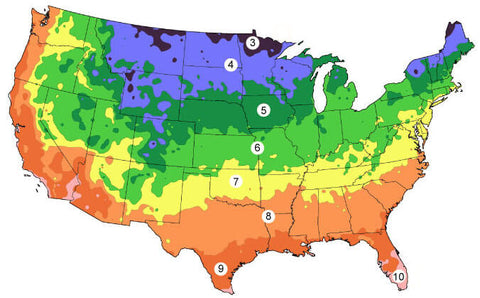When is My Last Frost Date?
Reference the NOAA chart below for your historical Last Freeze Date, then add 1-2 weeks to buffer against frost:

Determining the Last Frost Date Based on Your Hardiness Zone

As a gardener and plant lover, you know that your plants need plenty of love and attention. Sensitive to their environments, plants need the perfect balance of sunlight, water, and temperature to thrive. Finding this perfect balance as a plant owner involves a lot of planning and hard work, which is why the team at Garden Tower Project is here to help you figure your first and last frost date, hardiness zone, and supply you with tips for ensuring that your plants thrive in every environment. Using this information, you can make the most out of your Garden Tower ® 2 Vertical Planting System and plan for a bountiful harvest down the road.
How First and Last Frost Date is Determined
What is a First and Last Frost Date and What Does it Mean for My Plants?

Frost - ranging from a light freeze to a severe freeze - can damage even your strongest plants.
Frost dates are typically defined as the days in which there’s a 50% chance of being frost-free. In the spring, this date is your ‘last frost date’ and in the fall is if your ‘first frost date,’ both of which help determine the window in which the majority of your plants can stay safe from frost.
First and last frost dates range based on your hardiness zone. Within a single zone, the average frost dates can vary by as much as a week, which is why it’s important to pay attention to your hardiness zone and date-specific weather patterns when planting.
To help you sort through which dates are right based on your location, the chart above shows the average dates for the last spring frost and the first fall/winter frost dates for each USDA Hardiness Zone. As a general rule of (green) thumb, however, it’s advised to adjust these dates by two full weeks based on the ‘spring forward, fall back’ rule. In other words, your last frost date may average on March 1st-15th, but it’s safer to wait to plant between the 15th and 31st.
What is My Hardiness Zone?
Using Your Hardiness Zone to Determine the Last Frost Date

As we mentioned, your first and last frost dates are based on your hardiness zone, sometimes referred to as a ‘planting zone’ or ‘gardening zone.’ Here are a few resources for helping you find your hardiness zone based on where you live:
- Determining Your Hardiness Zone: Includes vegetable planting schedule, a hardiness zone look-up, and a germination temperature chart.
- Precise Growing Zones by State: Do you find yourself sitting on the edge of two zones? Check out this more precise chart. We recommend choosing the zone with a later last frost date to play it safe.
- Vegetable Planting Schedule by Zone: Your hardiness zone changes when specific vegetables should be planted -- double-check every vegetable in your garden before planting!
Tips for Ensuring Plant Safety with First and Last Frost Dates
4 Tips for Avoiding and Surviving a Surprise Frost
- Play it Safe: It’s better to plant a few days later than risk a frost that could kill your plants. Follow the spring forward and fall back rule for your last and first frost dates, respectively, to ensure warm enough temperatures.
- Check the Weather: Every year is different. While we have estimates on the average dates, always check the weather prior to planting to ensure your plants aren’t hit with a surprising frost.
- Move Inside if Needed: In the case of a surprise frost, the Garden Tower ® 2 System makes it possible to bring your plants inside overnight to avoid a frost that could kill your plants. Always use a partner or two to move your tower to avoid injury. Our Premium Caster Kit provides incredible mobility for such a large soil-based growing system.
- Cover Your Crops: At Garden Tower Project, we just push wooden, plastic, metal, or bamboo stakes into the tower and drape sheets, spun cloth, or plastic to protect from overnight unexpected frosts. Try to keep the protective covering from touching your plants (this provides an air-gap which insulates the plants from the light freeze or frost).
Ready to grow? Kick-off your season and learn how Garden Tower ® 2 Vertical Planting System can help you grow larger, healthier plants with less space now.


